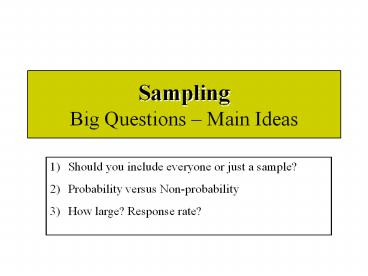Sampling Big Questions - PowerPoint PPT Presentation
1 / 16
Title:
Sampling Big Questions
Description:
Why do people watch Reality TV? Newspaper readers are more likely to vote ... population list, cf., talk. shows, happily married? For exploratory studies ... – PowerPoint PPT presentation
Number of Views:15
Avg rating:3.0/5.0
Title: Sampling Big Questions
1
SamplingBig Questions Main Ideas
- Should you include everyone or just a sample?
- Probability versus Non-probability
- How large? Response rate?
2
Sampling
- Why do people watch Reality TV?
- Newspaper readers are more likely to vote
- for Democrats than are non-readers
What types of sexual stereotypes against women
does the sitcom Roseanne perpetuate? What
persuasive tactics did Bill Clinton use in his
public rhetoric as President?
POPULATION all people who possess the
characteristic of interest. The relevant
characteristic of a population is the parameter
(Who is in and who is out?)
- Govt counts every member of natl population
- Survey every member of a small organization
UNIVERSE all non-people (texts) that share the
characteristics of interest.
- How students at Christian colleges
- use the internet . . .
CENSUS when researchers collect data from all
members of a population or a universe
SAMPLE subgroup of a population or a universe
-- a measurement of a sample with respect to a
variable is called a statistic.
3
Process
- STEP 1 identify the population you want to
describe - STEP 2 get a sampling frame (if possible)
- STEP 3 choose a method for selecting respondents
(random/non-random)
4
SAMPLING
generalizable
Sample
Population
a STATISTIC the summary description of a
given variable in a survey sample.
a PARAMETER the relevant Characteristic of a
population
BASIC PRINCIPLE OF PROBABILITY SAMPLING a sample
will be representative of the population from
which it is selected, IF all members of the
population have an equal chance of being selected
in the sample on each draw.
5
SAMPLING
ERROR
Sample
Population
Inherent ERROR
or - 2
Sampling the degree to which measurements
of the units/subjects selected differ from
those of the population as a whole
(margin of error)
Measurement inconsistencies produced
by the instrument used the way questions
are asked, etc.
6
SAMPLES
PROBABILITY
NON PROBABILITY
SIMPLE RANDOM SAMPLE equal chance for
selection must have complete list random number
table
CONVENIENCE SAMPLE available, Journals
VOLUNTEER SAMPLE advertised, rewards
SYSTEMATIC SAMPLE every nth subject sampling
rate, 1/4
PURPOSIVE SAMPLE selected on basis of specified
characteristics, e.g., twins
STRATIFIED SAMPLE selected from
homogeneous subsets of the population
QUOTA SAMPLE selected to meet a pre- determined
percentage, e.g., 70 women at SAU
CLUSTER SAMPLE selects the sample in groups or
categories, e.g., classes
HAPHAZARD SAMPLE every nth person
MULTISTAGE SAMPLE counties, districts,
blocks, households
SNOWBALL SAMPLE referrals, network
7
SAMPLES
PROBABILITY
NON PROBABILITY
Selected by mathematical guidelines
Does not follow mathematical guidelines
Allows the calculation of sampling error
Does not allow calculation of sampling error
Frequently used in media research
Systematic selection procedures
Less expensive, faster
Requires complete population list, cf.,
talk shows, happily married?
For exploratory studies
Limited generalizability
Generalizable
8
How Large Should Your Sample Be?
Depends on your research question and research
method
How much sampling error are you willing to
tolerate? (5, 1) -- (standard error)
Larger samples tend to reduce sampling error
(true population mean) IF randomly drawn
(table)
30 subjects in each group
Do you want to compare groups?(see p. 433,
Reinard)
9
The end
10
Simple Random Sample
- 357 students from a college of 5000 Calvin
College - Q. Relationship between religious commitment and
students sense of community on a Christian
college campus? - STEPS
- 1. Population parameter All 5000 students who
attend Calvin - 2. Complete list of population from registrars
office - 3. Assign each person a number 0001 to 5000
- 4. Random number table - select 357 subjects
- 5. or EXCEL!
11
Stratified Sample
- Question To what degree do students of differing
academic ability at SAU differ in communication
competence and communication adaptability? - FIRST
- divide students into groups high, average, low
- SECOND
- randomly sample within each group
12
Multistage Cluster Sampling
- QUESTION Americans attitudes toward political
advertisements in 2004 Presidential campaign - FIRST--select a few states at random
- SECOND--select a few counties
- THIRD--a few cities
- FOURTH--a few streets
- FIFTH--a few households, few members of each
Imagine
13
Multi-stage ClusterSample
U.S.A.
States
Counties
Cities
Streets
Households
Individuals
14
SAMPLING
ERROR?
Population
Sample
As Size of Sample Increases
Sampling Error Decreases
15
Confidence Interval
- Survey of SAU students, 300 randomly selected
respondents - 70 answer Yes (community is strong here on
campus) - Sampling error is /-9.2 (only because of random
sample) - This means that you add and Subtract 9.2 to 70
- You get a confidence interval (60.8 70
79.2) - Which means you are 95 confident that the true
proportion of the total population falls within
this range - Thus, if you were to sample from the same
population 95 more times, you could be sure that
70 would answer Yes, within 9.2 or
16
Sample Size Table
See Reinard, see p. 436































